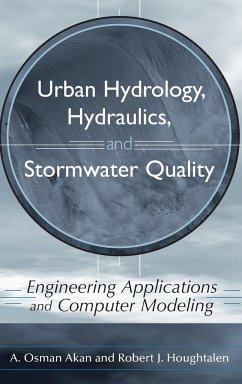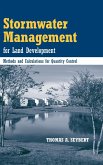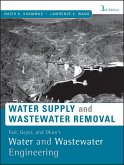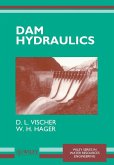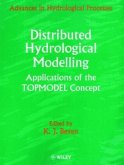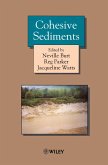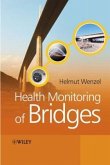Osman Akan, Robert J. Houghtalen
Urban Hydrology, Hydraulics, and Stormwater Quality
Engineering Applications and Computer Modeling
Osman Akan, Robert J. Houghtalen
Urban Hydrology, Hydraulics, and Stormwater Quality
Engineering Applications and Computer Modeling
- Gebundenes Buch
- Merkliste
- Auf die Merkliste
- Bewerten Bewerten
- Teilen
- Produkt teilen
- Produkterinnerung
- Produkterinnerung
A practical introduction on today's challenge of controlling and managing the water resources used by and affected by cities and urbanized communities. The book offers an integrated engineering approach, covering the spectrum of urban watershed management, urban hydraulic systems, and overall stormwater management.
Each chapter concludes with helpful problems.
Solutions Manual available to qualified professors and instructors upon request.
Introduces the reader to two popular, non-proprietary computer-modeling pro-grams: HEC-HMS (U.S. Army Corps of Engineers) and SWMM (U.S EPA).
Andere Kunden interessierten sich auch für
![Stormwater Management for Land Development Stormwater Management for Land Development]() Thomas A. SeybertStormwater Management for Land Development157,99 €
Thomas A. SeybertStormwater Management for Land Development157,99 €![Fair, Geyer, and Okun's Water and Wastewater Engineering Fair, Geyer, and Okun's Water and Wastewater Engineering]() Daniel A. OkunFair, Geyer, and Okun's Water and Wastewater Engineering321,99 €
Daniel A. OkunFair, Geyer, and Okun's Water and Wastewater Engineering321,99 €![Dam Hydraulics Dam Hydraulics]() Daniel L. VischerDam Hydraulics98,99 €
Daniel L. VischerDam Hydraulics98,99 €![Distributed Hydrological Modelling Distributed Hydrological Modelling]() K. J. Beven (Hrsg.)Distributed Hydrological Modelling215,99 €
K. J. Beven (Hrsg.)Distributed Hydrological Modelling215,99 €![Sonar and Underwater Acoustics Sonar and Underwater Acoustics]() Jean-Paul MarageSonar and Underwater Acoustics276,99 €
Jean-Paul MarageSonar and Underwater Acoustics276,99 €![Cohesive Sediments Cohesive Sediments]() Neville BurtCohesive Sediments322,99 €
Neville BurtCohesive Sediments322,99 €![Health Monitoring of Bridges Health Monitoring of Bridges]() Helmut WenzelHealth Monitoring of Bridges201,99 €
Helmut WenzelHealth Monitoring of Bridges201,99 €-
-
-
A practical introduction on today's challenge of controlling and managing the water resources used by and affected by cities and urbanized communities. The book offers an integrated engineering approach, covering the spectrum of urban watershed management, urban hydraulic systems, and overall stormwater management.
Each chapter concludes with helpful problems.
Solutions Manual available to qualified professors and instructors upon request.
Introduces the reader to two popular, non-proprietary computer-modeling pro-grams: HEC-HMS (U.S. Army Corps of Engineers) and SWMM (U.S EPA).
Hinweis: Dieser Artikel kann nur an eine deutsche Lieferadresse ausgeliefert werden.
Each chapter concludes with helpful problems.
Solutions Manual available to qualified professors and instructors upon request.
Introduces the reader to two popular, non-proprietary computer-modeling pro-grams: HEC-HMS (U.S. Army Corps of Engineers) and SWMM (U.S EPA).
Hinweis: Dieser Artikel kann nur an eine deutsche Lieferadresse ausgeliefert werden.
Produktdetails
- Produktdetails
- Verlag: Wiley & Sons
- 1. Auflage
- Seitenzahl: 392
- Erscheinungstermin: 22. August 2003
- Englisch
- Abmessung: 240mm x 161mm x 25mm
- Gewicht: 677g
- ISBN-13: 9780471431589
- ISBN-10: 0471431583
- Artikelnr.: 11748326
- Herstellerkennzeichnung
- Libri GmbH
- Europaallee 1
- 36244 Bad Hersfeld
- gpsr@libri.de
- Verlag: Wiley & Sons
- 1. Auflage
- Seitenzahl: 392
- Erscheinungstermin: 22. August 2003
- Englisch
- Abmessung: 240mm x 161mm x 25mm
- Gewicht: 677g
- ISBN-13: 9780471431589
- ISBN-10: 0471431583
- Artikelnr.: 11748326
- Herstellerkennzeichnung
- Libri GmbH
- Europaallee 1
- 36244 Bad Hersfeld
- gpsr@libri.de
A. OSMAN AKAN, PhD, PE, is Professor and current Chair of the Department of Civil and Environmental Engineering at Old Dominion University in Norfolk, Virginia. He has more than thirty years of teaching, research, and consulting experience in the general field of water resources engineering. His publication record includes Urban Stormwater Hydrology (Wiley), several chapters in design handbooks, and numerous articles in scholarly journals. ROBERT J. HOUGHTALEN, PhD, is Professor and Head of the Civil Engineering Department at the Rose-Hulman Institute of Technology in Terre Haute, Indiana. During his thirty years of experience in water resources, his publishing credits include Fundamentals of Hydraulic Engineering Systems, Third Edition (with Ned H. C. Hwang) and the Federal Highway Administration's Hydraulic Design of Highway Culverts, Second Edition (HDS 5) (with Jerome M. Normann and William J. Johnston). For more than fifteen years, he has taught the EPA-SWMM model and the Corps of Engineers' HEC-HMS model in continuing education classes for ASCE.
Preface.
Acknowledgments.
1 Introduction.
1.1 Urbanization and Stormwater Runoff.
1.2 Urban Hydrology, Hydraulics, and Stormwater Quality.
1.3 Organization of the Book.
Problems.
2 Rainfall for Designing Urban Drainage Systems.
2.1 Hydrologic Description of Rainfall.
2.2 Probabilistic Description of Rainfall.
2.2.1 Return Period and Hydrologic Risk.
2.2.2 Frequency Analysis.
2.2.3 Intensity-Duration-Return Period Curves.
2.2.4 Mathematical Intensity-Duration Relationships.
2.3 Design Rainfall.
2.3.1 Continuous Simulation and Single-Event Methods.
2.3.2 Design Return Period.
2.3.3 Design-Storm Duration and Depth.
2.3.4 Spatial and Temporal Distribution of Design Rainfall.
2.4 Construction of Design-Storm Hyetographs.
2.4.1 Soil Conservation Service Method.
2.4.2 Yen and Chow Method.
2.4.3 Huff Method.
2.4.4 Synthetic Block Hyetograph Method.
2.4.5 Chicago Method.
Problems.
References.
3 Rainfall Excess Calculations.
3.1 Calculation of Rainfall Abstractions.
3.1.1 Interception Storage.
3.1.2 Infiltration.
3.1.3 Depression Storage.
3.2 Combined Loss Models.
3.2.1 Soil Conservation Service Method.
3.2.2 Other Combined Loss Models.
Problems.
References.
4 Rainfall Excess and Open-Channel Flow in Urban Watersheds.
4.1 Open-Channel Hydraulics.
4.1.1 Basic Definitions.
4.1.2 States of Open-Channel Flow.
4.1.3 Open-Channel Flow Equations.
4.1.4 Steady Gradually Varied Flow.
4.1.5 Normal Flow.
4.1.6 Open-Channel Rating Curve.
4.2 Overland Flow.
4.2.1 Kinematic-Wave Model.
4.2.2 Overland Flow on Impervious Surfaces.
4.2.3 Overland Flow on Pervious Surfaces.
4.3 Channel Flow.
4.3.1 Muskingum Method.
4.3.2 Muskingum-Cunge Method.
4.3.3 Muskingum-Cunge Method for Routing with Lateral Inflow.
4.3.4 Modified Att-Kin Method.
Problems.
References.
5 Calculation of Runoff Rates From Urban Watersheds.
5.1 Basic Concepts.
5.1.1 Elements of Urban Runoff Hydrographs.
5.1.2 Definition of Time of Concentration.
5.2 Calculation of Time of Concentration.
5.2.1 SCS Time-of-Concentration Method.
5.2.2 Kinematic Time-of-Concentration Formulas.
5.2.3 Kirpich Formula.
5.3 Unit Hydrograph Method.
5.3.1 Unit Hydrograph Development.
5.3.2 Application of the Unit Hydrograph Method.
5.4 Soil Conservation ServiceMethods for Runoff Rate Calculations.
5.4.1 TR-55 Graphical Peak Discharge Method.
5.4.2 TR-55 Tabular Hydrograph Method.
5.5 The Santa Barbara Urban Hydrograph Method.
5.6 USGS Regression Equations.
5.7 The Rational Method.
5.8 The Kinematic-Rational Methods.
Problems.
References.
6 Stormwater Drainage Structures.
6.1 Drainage of Street Pavements.
6.1.1 General Design Considerations.
6.1.2 Flow in Gutters.
6.1.3 Pavement Drainage Inlets.
6.1.4 Pavement Drainage Inlet Locations.
6.2 Storm Sewer Systems.
6.2.1 Storm Sewer Hydraulics.
6.2.2 Design Discharge for Storm Sewers.
6.2.3 Sizing Storm Sewers.
6.2.4 Hydraulic Grade Line Considerations.
6.2.5 Storm Sewer System Design Calculations.
6.3 Culverts.
6.3.1 Inlet Control Flow.
6.3.2 Outlet Control Flow.
6.3.3 Sizing of Culverts.
6.4 Design of Surface Drainage Channels.
6.4.1 Design of Unlined Channels.
6.4.2 Design of Grass-Lined Channels.
Problems.
References.
Suggested Reading.
7 Stormwater Detention for Quantity Management.
7.1 Detention Basins.
7.1.1 Stage-Storage Relationship.
7.1.2 Stage-Discharge Relationship.
7.1.3 Pond Routing.
7.1.4 Pond-Routing Charts.
7.1.5 Design of Detention Basins.
7.2 Infiltration Practices.
7.2.1 Capture Volume.
7.2.2 Soil Textures.
7.2.3 Infiltration Basins.
7.2.4 Infiltration Trenches.
7.2.5 Dry Wells.
7.2.6 Porous Pavements.
Problems.
References.
Suggested Reading.
8 Urban Stormwater Pollution.
8.1 Modeling Urban Stormwater Quality.
8.1.1 Solids Buildup and Wash-off from Impervious Areas.
8.1.2 Solids Wash-off from Pervious Surfaces.
8.1.3 Wash-off of Pollutants Other than Solids.
8.1.4 Pollutographs and Loadographs.
8.2 Annual Pollutant Load Estimates.
8.2.1 EPA Model for Annual Pollutant Loading Estimation.
8.2.2 U.S. Geological Survey Model for Mean Annual Loads.
8.2.3 Metropolitan Washington Council of Governments Method.
Problems.
References.
9 Best Management Practices for Urban Stormwater Quality Control.
9.1 Extended Detention Basins.
9.1.1 Sizing Extended Detention Basins.
9.1.2 Sizing Water Quality Outlet Devices.
9.1.3 Additional Extended Detention Basin Design Considerations.
9.2 Retention Basins.
9.2.1 Permanent Pool Volume.
9.2.2 Retention Basin Design Considerations.
9.2.3 EPA Methodology for Analysis of Wet Pond Detention Basins.
9.3 Water Quality Trenches.
9.4 Sand Filters.
9.5 Stormwater Wetlands.
9.6 Other Vegetative BMPs.
9.6.1 Grass Swales.
9.6.2 Filter Strips.
9.7 The National Stormwater BMP Database.
Problems.
References.
10 Urban Stormwater Computer Models: HEC-HMS and EPA-SWMM.
10.1 Hydrologic Modeling Overview and Watershed Delineation.
10.2 Model Structure and Features of HEC-HMS.
10.3 Technical Capabilities of HEC-HMS.
10.4 HEC-HMS Example Problem.
10.5 Structure and Features of EPA-SWMM.
10.6 Technical Capabilities of EPA-SWMM.
10.7 EPA-SWMM Example Problem.
10.8 Model Calibration and Verification.
Problems.
References.
Suggested Reading.
Appendix 1: Tabular Hydrograph Unit Discharges for SCS Type II Rainfall
Distribution.
Index.
Acknowledgments.
1 Introduction.
1.1 Urbanization and Stormwater Runoff.
1.2 Urban Hydrology, Hydraulics, and Stormwater Quality.
1.3 Organization of the Book.
Problems.
2 Rainfall for Designing Urban Drainage Systems.
2.1 Hydrologic Description of Rainfall.
2.2 Probabilistic Description of Rainfall.
2.2.1 Return Period and Hydrologic Risk.
2.2.2 Frequency Analysis.
2.2.3 Intensity-Duration-Return Period Curves.
2.2.4 Mathematical Intensity-Duration Relationships.
2.3 Design Rainfall.
2.3.1 Continuous Simulation and Single-Event Methods.
2.3.2 Design Return Period.
2.3.3 Design-Storm Duration and Depth.
2.3.4 Spatial and Temporal Distribution of Design Rainfall.
2.4 Construction of Design-Storm Hyetographs.
2.4.1 Soil Conservation Service Method.
2.4.2 Yen and Chow Method.
2.4.3 Huff Method.
2.4.4 Synthetic Block Hyetograph Method.
2.4.5 Chicago Method.
Problems.
References.
3 Rainfall Excess Calculations.
3.1 Calculation of Rainfall Abstractions.
3.1.1 Interception Storage.
3.1.2 Infiltration.
3.1.3 Depression Storage.
3.2 Combined Loss Models.
3.2.1 Soil Conservation Service Method.
3.2.2 Other Combined Loss Models.
Problems.
References.
4 Rainfall Excess and Open-Channel Flow in Urban Watersheds.
4.1 Open-Channel Hydraulics.
4.1.1 Basic Definitions.
4.1.2 States of Open-Channel Flow.
4.1.3 Open-Channel Flow Equations.
4.1.4 Steady Gradually Varied Flow.
4.1.5 Normal Flow.
4.1.6 Open-Channel Rating Curve.
4.2 Overland Flow.
4.2.1 Kinematic-Wave Model.
4.2.2 Overland Flow on Impervious Surfaces.
4.2.3 Overland Flow on Pervious Surfaces.
4.3 Channel Flow.
4.3.1 Muskingum Method.
4.3.2 Muskingum-Cunge Method.
4.3.3 Muskingum-Cunge Method for Routing with Lateral Inflow.
4.3.4 Modified Att-Kin Method.
Problems.
References.
5 Calculation of Runoff Rates From Urban Watersheds.
5.1 Basic Concepts.
5.1.1 Elements of Urban Runoff Hydrographs.
5.1.2 Definition of Time of Concentration.
5.2 Calculation of Time of Concentration.
5.2.1 SCS Time-of-Concentration Method.
5.2.2 Kinematic Time-of-Concentration Formulas.
5.2.3 Kirpich Formula.
5.3 Unit Hydrograph Method.
5.3.1 Unit Hydrograph Development.
5.3.2 Application of the Unit Hydrograph Method.
5.4 Soil Conservation ServiceMethods for Runoff Rate Calculations.
5.4.1 TR-55 Graphical Peak Discharge Method.
5.4.2 TR-55 Tabular Hydrograph Method.
5.5 The Santa Barbara Urban Hydrograph Method.
5.6 USGS Regression Equations.
5.7 The Rational Method.
5.8 The Kinematic-Rational Methods.
Problems.
References.
6 Stormwater Drainage Structures.
6.1 Drainage of Street Pavements.
6.1.1 General Design Considerations.
6.1.2 Flow in Gutters.
6.1.3 Pavement Drainage Inlets.
6.1.4 Pavement Drainage Inlet Locations.
6.2 Storm Sewer Systems.
6.2.1 Storm Sewer Hydraulics.
6.2.2 Design Discharge for Storm Sewers.
6.2.3 Sizing Storm Sewers.
6.2.4 Hydraulic Grade Line Considerations.
6.2.5 Storm Sewer System Design Calculations.
6.3 Culverts.
6.3.1 Inlet Control Flow.
6.3.2 Outlet Control Flow.
6.3.3 Sizing of Culverts.
6.4 Design of Surface Drainage Channels.
6.4.1 Design of Unlined Channels.
6.4.2 Design of Grass-Lined Channels.
Problems.
References.
Suggested Reading.
7 Stormwater Detention for Quantity Management.
7.1 Detention Basins.
7.1.1 Stage-Storage Relationship.
7.1.2 Stage-Discharge Relationship.
7.1.3 Pond Routing.
7.1.4 Pond-Routing Charts.
7.1.5 Design of Detention Basins.
7.2 Infiltration Practices.
7.2.1 Capture Volume.
7.2.2 Soil Textures.
7.2.3 Infiltration Basins.
7.2.4 Infiltration Trenches.
7.2.5 Dry Wells.
7.2.6 Porous Pavements.
Problems.
References.
Suggested Reading.
8 Urban Stormwater Pollution.
8.1 Modeling Urban Stormwater Quality.
8.1.1 Solids Buildup and Wash-off from Impervious Areas.
8.1.2 Solids Wash-off from Pervious Surfaces.
8.1.3 Wash-off of Pollutants Other than Solids.
8.1.4 Pollutographs and Loadographs.
8.2 Annual Pollutant Load Estimates.
8.2.1 EPA Model for Annual Pollutant Loading Estimation.
8.2.2 U.S. Geological Survey Model for Mean Annual Loads.
8.2.3 Metropolitan Washington Council of Governments Method.
Problems.
References.
9 Best Management Practices for Urban Stormwater Quality Control.
9.1 Extended Detention Basins.
9.1.1 Sizing Extended Detention Basins.
9.1.2 Sizing Water Quality Outlet Devices.
9.1.3 Additional Extended Detention Basin Design Considerations.
9.2 Retention Basins.
9.2.1 Permanent Pool Volume.
9.2.2 Retention Basin Design Considerations.
9.2.3 EPA Methodology for Analysis of Wet Pond Detention Basins.
9.3 Water Quality Trenches.
9.4 Sand Filters.
9.5 Stormwater Wetlands.
9.6 Other Vegetative BMPs.
9.6.1 Grass Swales.
9.6.2 Filter Strips.
9.7 The National Stormwater BMP Database.
Problems.
References.
10 Urban Stormwater Computer Models: HEC-HMS and EPA-SWMM.
10.1 Hydrologic Modeling Overview and Watershed Delineation.
10.2 Model Structure and Features of HEC-HMS.
10.3 Technical Capabilities of HEC-HMS.
10.4 HEC-HMS Example Problem.
10.5 Structure and Features of EPA-SWMM.
10.6 Technical Capabilities of EPA-SWMM.
10.7 EPA-SWMM Example Problem.
10.8 Model Calibration and Verification.
Problems.
References.
Suggested Reading.
Appendix 1: Tabular Hydrograph Unit Discharges for SCS Type II Rainfall
Distribution.
Index.
Preface.
Acknowledgments.
1 Introduction.
1.1 Urbanization and Stormwater Runoff.
1.2 Urban Hydrology, Hydraulics, and Stormwater Quality.
1.3 Organization of the Book.
Problems.
2 Rainfall for Designing Urban Drainage Systems.
2.1 Hydrologic Description of Rainfall.
2.2 Probabilistic Description of Rainfall.
2.2.1 Return Period and Hydrologic Risk.
2.2.2 Frequency Analysis.
2.2.3 Intensity-Duration-Return Period Curves.
2.2.4 Mathematical Intensity-Duration Relationships.
2.3 Design Rainfall.
2.3.1 Continuous Simulation and Single-Event Methods.
2.3.2 Design Return Period.
2.3.3 Design-Storm Duration and Depth.
2.3.4 Spatial and Temporal Distribution of Design Rainfall.
2.4 Construction of Design-Storm Hyetographs.
2.4.1 Soil Conservation Service Method.
2.4.2 Yen and Chow Method.
2.4.3 Huff Method.
2.4.4 Synthetic Block Hyetograph Method.
2.4.5 Chicago Method.
Problems.
References.
3 Rainfall Excess Calculations.
3.1 Calculation of Rainfall Abstractions.
3.1.1 Interception Storage.
3.1.2 Infiltration.
3.1.3 Depression Storage.
3.2 Combined Loss Models.
3.2.1 Soil Conservation Service Method.
3.2.2 Other Combined Loss Models.
Problems.
References.
4 Rainfall Excess and Open-Channel Flow in Urban Watersheds.
4.1 Open-Channel Hydraulics.
4.1.1 Basic Definitions.
4.1.2 States of Open-Channel Flow.
4.1.3 Open-Channel Flow Equations.
4.1.4 Steady Gradually Varied Flow.
4.1.5 Normal Flow.
4.1.6 Open-Channel Rating Curve.
4.2 Overland Flow.
4.2.1 Kinematic-Wave Model.
4.2.2 Overland Flow on Impervious Surfaces.
4.2.3 Overland Flow on Pervious Surfaces.
4.3 Channel Flow.
4.3.1 Muskingum Method.
4.3.2 Muskingum-Cunge Method.
4.3.3 Muskingum-Cunge Method for Routing with Lateral Inflow.
4.3.4 Modified Att-Kin Method.
Problems.
References.
5 Calculation of Runoff Rates From Urban Watersheds.
5.1 Basic Concepts.
5.1.1 Elements of Urban Runoff Hydrographs.
5.1.2 Definition of Time of Concentration.
5.2 Calculation of Time of Concentration.
5.2.1 SCS Time-of-Concentration Method.
5.2.2 Kinematic Time-of-Concentration Formulas.
5.2.3 Kirpich Formula.
5.3 Unit Hydrograph Method.
5.3.1 Unit Hydrograph Development.
5.3.2 Application of the Unit Hydrograph Method.
5.4 Soil Conservation ServiceMethods for Runoff Rate Calculations.
5.4.1 TR-55 Graphical Peak Discharge Method.
5.4.2 TR-55 Tabular Hydrograph Method.
5.5 The Santa Barbara Urban Hydrograph Method.
5.6 USGS Regression Equations.
5.7 The Rational Method.
5.8 The Kinematic-Rational Methods.
Problems.
References.
6 Stormwater Drainage Structures.
6.1 Drainage of Street Pavements.
6.1.1 General Design Considerations.
6.1.2 Flow in Gutters.
6.1.3 Pavement Drainage Inlets.
6.1.4 Pavement Drainage Inlet Locations.
6.2 Storm Sewer Systems.
6.2.1 Storm Sewer Hydraulics.
6.2.2 Design Discharge for Storm Sewers.
6.2.3 Sizing Storm Sewers.
6.2.4 Hydraulic Grade Line Considerations.
6.2.5 Storm Sewer System Design Calculations.
6.3 Culverts.
6.3.1 Inlet Control Flow.
6.3.2 Outlet Control Flow.
6.3.3 Sizing of Culverts.
6.4 Design of Surface Drainage Channels.
6.4.1 Design of Unlined Channels.
6.4.2 Design of Grass-Lined Channels.
Problems.
References.
Suggested Reading.
7 Stormwater Detention for Quantity Management.
7.1 Detention Basins.
7.1.1 Stage-Storage Relationship.
7.1.2 Stage-Discharge Relationship.
7.1.3 Pond Routing.
7.1.4 Pond-Routing Charts.
7.1.5 Design of Detention Basins.
7.2 Infiltration Practices.
7.2.1 Capture Volume.
7.2.2 Soil Textures.
7.2.3 Infiltration Basins.
7.2.4 Infiltration Trenches.
7.2.5 Dry Wells.
7.2.6 Porous Pavements.
Problems.
References.
Suggested Reading.
8 Urban Stormwater Pollution.
8.1 Modeling Urban Stormwater Quality.
8.1.1 Solids Buildup and Wash-off from Impervious Areas.
8.1.2 Solids Wash-off from Pervious Surfaces.
8.1.3 Wash-off of Pollutants Other than Solids.
8.1.4 Pollutographs and Loadographs.
8.2 Annual Pollutant Load Estimates.
8.2.1 EPA Model for Annual Pollutant Loading Estimation.
8.2.2 U.S. Geological Survey Model for Mean Annual Loads.
8.2.3 Metropolitan Washington Council of Governments Method.
Problems.
References.
9 Best Management Practices for Urban Stormwater Quality Control.
9.1 Extended Detention Basins.
9.1.1 Sizing Extended Detention Basins.
9.1.2 Sizing Water Quality Outlet Devices.
9.1.3 Additional Extended Detention Basin Design Considerations.
9.2 Retention Basins.
9.2.1 Permanent Pool Volume.
9.2.2 Retention Basin Design Considerations.
9.2.3 EPA Methodology for Analysis of Wet Pond Detention Basins.
9.3 Water Quality Trenches.
9.4 Sand Filters.
9.5 Stormwater Wetlands.
9.6 Other Vegetative BMPs.
9.6.1 Grass Swales.
9.6.2 Filter Strips.
9.7 The National Stormwater BMP Database.
Problems.
References.
10 Urban Stormwater Computer Models: HEC-HMS and EPA-SWMM.
10.1 Hydrologic Modeling Overview and Watershed Delineation.
10.2 Model Structure and Features of HEC-HMS.
10.3 Technical Capabilities of HEC-HMS.
10.4 HEC-HMS Example Problem.
10.5 Structure and Features of EPA-SWMM.
10.6 Technical Capabilities of EPA-SWMM.
10.7 EPA-SWMM Example Problem.
10.8 Model Calibration and Verification.
Problems.
References.
Suggested Reading.
Appendix 1: Tabular Hydrograph Unit Discharges for SCS Type II Rainfall
Distribution.
Index.
Acknowledgments.
1 Introduction.
1.1 Urbanization and Stormwater Runoff.
1.2 Urban Hydrology, Hydraulics, and Stormwater Quality.
1.3 Organization of the Book.
Problems.
2 Rainfall for Designing Urban Drainage Systems.
2.1 Hydrologic Description of Rainfall.
2.2 Probabilistic Description of Rainfall.
2.2.1 Return Period and Hydrologic Risk.
2.2.2 Frequency Analysis.
2.2.3 Intensity-Duration-Return Period Curves.
2.2.4 Mathematical Intensity-Duration Relationships.
2.3 Design Rainfall.
2.3.1 Continuous Simulation and Single-Event Methods.
2.3.2 Design Return Period.
2.3.3 Design-Storm Duration and Depth.
2.3.4 Spatial and Temporal Distribution of Design Rainfall.
2.4 Construction of Design-Storm Hyetographs.
2.4.1 Soil Conservation Service Method.
2.4.2 Yen and Chow Method.
2.4.3 Huff Method.
2.4.4 Synthetic Block Hyetograph Method.
2.4.5 Chicago Method.
Problems.
References.
3 Rainfall Excess Calculations.
3.1 Calculation of Rainfall Abstractions.
3.1.1 Interception Storage.
3.1.2 Infiltration.
3.1.3 Depression Storage.
3.2 Combined Loss Models.
3.2.1 Soil Conservation Service Method.
3.2.2 Other Combined Loss Models.
Problems.
References.
4 Rainfall Excess and Open-Channel Flow in Urban Watersheds.
4.1 Open-Channel Hydraulics.
4.1.1 Basic Definitions.
4.1.2 States of Open-Channel Flow.
4.1.3 Open-Channel Flow Equations.
4.1.4 Steady Gradually Varied Flow.
4.1.5 Normal Flow.
4.1.6 Open-Channel Rating Curve.
4.2 Overland Flow.
4.2.1 Kinematic-Wave Model.
4.2.2 Overland Flow on Impervious Surfaces.
4.2.3 Overland Flow on Pervious Surfaces.
4.3 Channel Flow.
4.3.1 Muskingum Method.
4.3.2 Muskingum-Cunge Method.
4.3.3 Muskingum-Cunge Method for Routing with Lateral Inflow.
4.3.4 Modified Att-Kin Method.
Problems.
References.
5 Calculation of Runoff Rates From Urban Watersheds.
5.1 Basic Concepts.
5.1.1 Elements of Urban Runoff Hydrographs.
5.1.2 Definition of Time of Concentration.
5.2 Calculation of Time of Concentration.
5.2.1 SCS Time-of-Concentration Method.
5.2.2 Kinematic Time-of-Concentration Formulas.
5.2.3 Kirpich Formula.
5.3 Unit Hydrograph Method.
5.3.1 Unit Hydrograph Development.
5.3.2 Application of the Unit Hydrograph Method.
5.4 Soil Conservation ServiceMethods for Runoff Rate Calculations.
5.4.1 TR-55 Graphical Peak Discharge Method.
5.4.2 TR-55 Tabular Hydrograph Method.
5.5 The Santa Barbara Urban Hydrograph Method.
5.6 USGS Regression Equations.
5.7 The Rational Method.
5.8 The Kinematic-Rational Methods.
Problems.
References.
6 Stormwater Drainage Structures.
6.1 Drainage of Street Pavements.
6.1.1 General Design Considerations.
6.1.2 Flow in Gutters.
6.1.3 Pavement Drainage Inlets.
6.1.4 Pavement Drainage Inlet Locations.
6.2 Storm Sewer Systems.
6.2.1 Storm Sewer Hydraulics.
6.2.2 Design Discharge for Storm Sewers.
6.2.3 Sizing Storm Sewers.
6.2.4 Hydraulic Grade Line Considerations.
6.2.5 Storm Sewer System Design Calculations.
6.3 Culverts.
6.3.1 Inlet Control Flow.
6.3.2 Outlet Control Flow.
6.3.3 Sizing of Culverts.
6.4 Design of Surface Drainage Channels.
6.4.1 Design of Unlined Channels.
6.4.2 Design of Grass-Lined Channels.
Problems.
References.
Suggested Reading.
7 Stormwater Detention for Quantity Management.
7.1 Detention Basins.
7.1.1 Stage-Storage Relationship.
7.1.2 Stage-Discharge Relationship.
7.1.3 Pond Routing.
7.1.4 Pond-Routing Charts.
7.1.5 Design of Detention Basins.
7.2 Infiltration Practices.
7.2.1 Capture Volume.
7.2.2 Soil Textures.
7.2.3 Infiltration Basins.
7.2.4 Infiltration Trenches.
7.2.5 Dry Wells.
7.2.6 Porous Pavements.
Problems.
References.
Suggested Reading.
8 Urban Stormwater Pollution.
8.1 Modeling Urban Stormwater Quality.
8.1.1 Solids Buildup and Wash-off from Impervious Areas.
8.1.2 Solids Wash-off from Pervious Surfaces.
8.1.3 Wash-off of Pollutants Other than Solids.
8.1.4 Pollutographs and Loadographs.
8.2 Annual Pollutant Load Estimates.
8.2.1 EPA Model for Annual Pollutant Loading Estimation.
8.2.2 U.S. Geological Survey Model for Mean Annual Loads.
8.2.3 Metropolitan Washington Council of Governments Method.
Problems.
References.
9 Best Management Practices for Urban Stormwater Quality Control.
9.1 Extended Detention Basins.
9.1.1 Sizing Extended Detention Basins.
9.1.2 Sizing Water Quality Outlet Devices.
9.1.3 Additional Extended Detention Basin Design Considerations.
9.2 Retention Basins.
9.2.1 Permanent Pool Volume.
9.2.2 Retention Basin Design Considerations.
9.2.3 EPA Methodology for Analysis of Wet Pond Detention Basins.
9.3 Water Quality Trenches.
9.4 Sand Filters.
9.5 Stormwater Wetlands.
9.6 Other Vegetative BMPs.
9.6.1 Grass Swales.
9.6.2 Filter Strips.
9.7 The National Stormwater BMP Database.
Problems.
References.
10 Urban Stormwater Computer Models: HEC-HMS and EPA-SWMM.
10.1 Hydrologic Modeling Overview and Watershed Delineation.
10.2 Model Structure and Features of HEC-HMS.
10.3 Technical Capabilities of HEC-HMS.
10.4 HEC-HMS Example Problem.
10.5 Structure and Features of EPA-SWMM.
10.6 Technical Capabilities of EPA-SWMM.
10.7 EPA-SWMM Example Problem.
10.8 Model Calibration and Verification.
Problems.
References.
Suggested Reading.
Appendix 1: Tabular Hydrograph Unit Discharges for SCS Type II Rainfall
Distribution.
Index.

